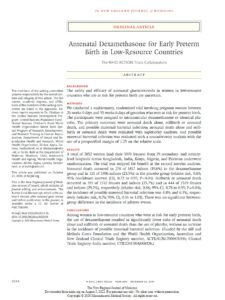
BACKGROUND
The safety and efficacy of antenatal glucocorticoids in women in low-resource countries who are at risk for preterm birth are uncertain.
Methods
We conducted a multicountry, randomized trial involving pregnant women between 26 weeks 0 days and 33 weeks 6 days of gestation who were at risk for preterm birth. The participants were assigned to intramuscular dexamethasone or identical placebo. The primary outcomes were neonatal death alone, stillbirth or neonatal death, and possible maternal bacterial infection; neonatal death alone and stillbirth or neonatal death were evaluated with superiority analyses, and possible maternal bacterial infection was evaluated with a noninferiority analysis with the use of a prespecified margin of 1.25 on the relative scale.
Primary Outcomes
There were 278 neonatal deaths among 1417 live-born infants in the dexamethasone group (19.6%) and 331 neonatal deaths among 1406 live-born infants in the placebo group (23.5%) (relative risk, 0.84; 95% confidence interval [CI], 0.72 to 0.97; P=0.03) (Table 2). We determined that 25 women would need to be treated with dexamethasone to prevent 1 neonatal death (95% CI, 14 to 110). The incidence of stillbirth or neonatal death was also significantly lower in the dexamethasone group than in the placebo group (25.7% vs. 29.2%; relative risk, 0.88; 95% CI, 0.78 to 0.99; P=0.04).
Possible maternal bacterial infection occurred in 68 of 1416 women (4.8%) in the dexamethasone group and in 89 of 1412 women (6.3%) in the placebo group (relative risk, 0.76; 95% CI, 0.56 to 1.03; P=0.002 for noninferiority); this result was consistent with noninferiority at the prespecified margin of 1.25 (Table 2). In the per-protocol population, possible maternal bacterial infection occurred in 63 of 1393 women (4.5%) in the dexamethasone group and in 89 of 1385 women (6.4%) in the placebo group (relative risk, 0.70; 95% CI, 0.51 to 0.96); this result was also consistent with noninferiority. Multiple imputation for missing values11 yielded identical results for all the primary outcomes (Table S3).
The results according to the prespecified subgroups are shown in Figure 2 and Figure S1. Analyses of neonatal death, according to the time from the first dose of dexamethasone or placebo to birth, stratified according to gestational age, suggest greater benefit with increasing time from the first dose to birth and increasing gestational age at the first dose (from 26 to 32 weeks) (Fig. S2). In a post hoc analysis of the causes of neonatal death, the frequency of neonatal death caused by respiratory distress syndrome was lower in the dexamethasone group than in the placebo group (Table S4).